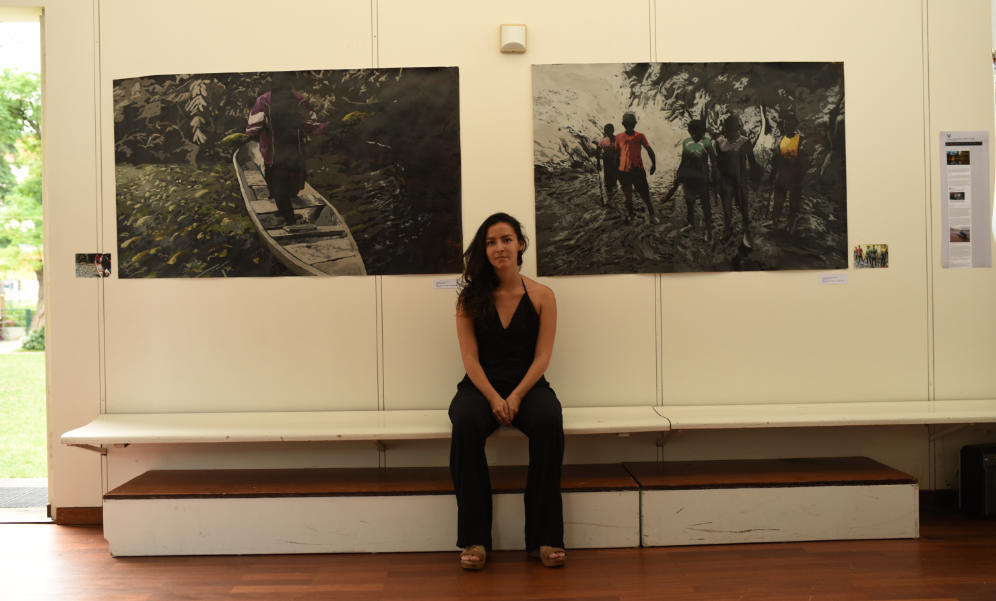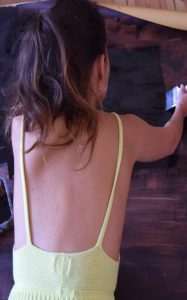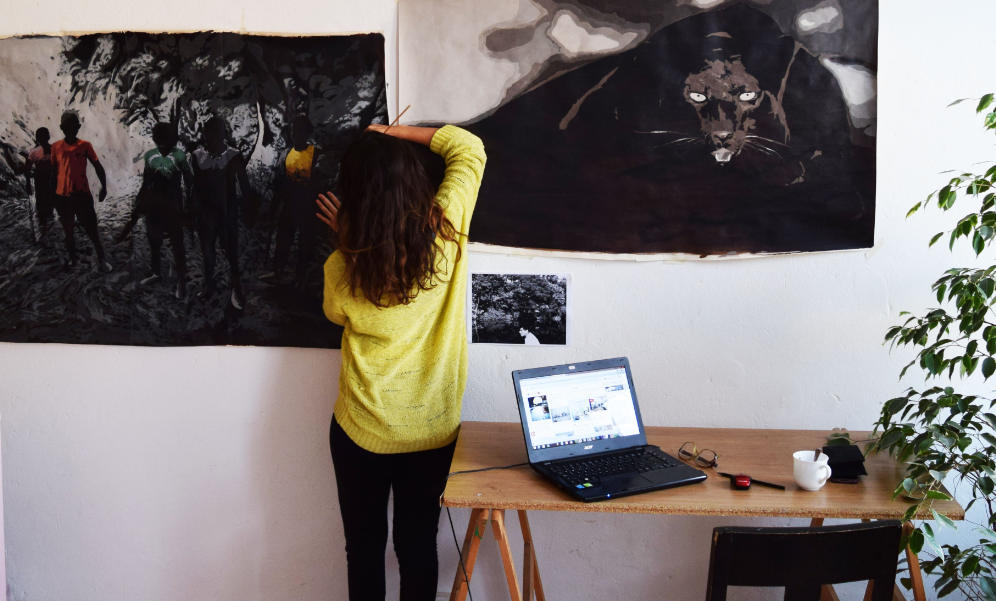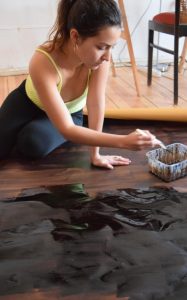Who is Helga, as readers are wondering, she is an artist and activist for Earth issues, especially the Amazon area. She grew up in Peru, and currently lives in Berlin. She works, creates and communicates in different languages. Like many migrants, she has a social and aesthetic commitment which is evident in her work and daily activities.
I have been invited to conduct this interview, a cybernetic meeting in this case, since we live in Corona – Pandemic times. In this way, I invite you to read it interactively, and if possible, if your interest has been awakened, see her artistic proposals, and participate in future events. Art for Helga is active and empathetic. So let’s “come down” to read and be part of this voice.

Helga in Berlin
We started the video call, I want to mention that the interview was carried out in two days, one afternoon during the week in isolation, and one Friday morning the following week, when we greeted each other we commented on how calm the “quarantine” was passing by.
At the moment, she is working at home on some portraits, a painting “and my clay has just arrived”. With her computer camera, she shows me a sculpture in progress.
At the University I did not work much on sculpture but now I want to get away from technology a bit and work more with my hands.
She hasn’t been out lately, only to go shopping for groceries. Helga lives near Tempelhof and walks around, but for the moment she is focused on her work, painting and some illustrations.
Today she does not have much time for the interview and she wants to cook a cause (Peruvian dish) and go to the store before they close, tomorrow is a holiday and it won’t be open.

She asks me if I have tried this dish, I told her that I have only eaten the huancaína potato, she laughs and tells me that it is the recipe that her Peruvian patriots cook the most in Germany given that the ingredients are easy to find here. Before, she was worried about going to the store in Mitte to get the Peruvian ingredients and the chili peppers, but now she cooks with what she has, sometimes the recipe changes.
I thanked her for her mail and I commented on the lines of the interview. I had read a little of her thanks to her website but I wanted to hear her voice. I wanted to know about her life, her work in the Amazon and her life now in Berlin.
She told me about her first trip, which was to visit her older sister who lives in Munich, a city that she did not like very much. “It is very clean” she said and did not find people with the same interests. On the second visit to Germany, she arrived in Berlin to take a course for 3 days at the Universität der Künste UdK, a University that would be a theoretical space for three years. A place where Art and its market are discussed and how they can get subsidies, and live on their creations or projects, not only in Art History as in the Faculty in Peru.
Helga currently works for the association called OASE-Berlin as a link and helps migrants to open their associations and puts them in contact with government agencies or programs. Although it is true that she lives in Neukölln in a WG, thanks to her work she has known the neighborhoods of Pankow and Prenzlauer Berg, and their people who are a little different.
Although her neighborhood has always been Neukölln, her first winter in Berlin was difficult not because of the cold but because of the light.
I lived at home with a friend and in the same room where I slept, painted, so I bought a lamp to be able to paint after 3 in the afternoon, because it gets dark very early, it’s always dark in winter.
Helga in Peru
But before Berlin was Lima, a place where she lived with her family and studied painting for 6 years, about European art and specifically the romantic style seen from the Eurocentric perspective, “which is still seen in her work,” she says. Her search, after having several experiences and questions abroad about her own identity, made her look for her non-Western cultural heritage absent in her education in her native country.
Her last job in Peru was in the Amazon area in the Cuninico community, (she writes me the name in the chat so that I have no problem writing it in the article). Her experience was shocking since she traveled when there was a very notable oil spill and when talking with community members they shared that there was not much social knowledge about the problem, only one local channel covered this tragic event.
I got sick for a month and would not stop coughing. I realized that the materials we work with on a daily basis can be toxic, such as white spirit when cleaning brushes that smells very bad. In Lima I found walnut, which is a pigment that dissolves with water, now it is the one I work with.
The Community of Cuninico, of the Kukama Indigenous People, is located in the northeastern jungle of Peru, on the banks of the Marañón River, at the entrance to the Cuninico creek. It has approximately 600 inhabitants who since 2014 have been exposed to heavy metals and other chemical substances thanks to its relationship and proximity to the river water which is contaminated with these substances.
Helga knows that it is a controversial issue and it was not a problem to participate in collaboration with the artist Tomás Saraceno and a group of artist friends and activists to demonstrate in front of the COP-21 (United Nations Conference on Climate Change) cooperating in his work Aerocene, “some sculptures made of plastic that can fly without harmful emissions to the environment ”- she mentions. From that moment on, it was that she made a reflection since in previous works he painted with oils.
But tell me more about your experience in the Amazon, is your family there, what it is like, who accompanied you. Her mother was from San Martín, northern part of the Peruvian Amazon jungle. A friend accompanied her. She told her parents that they were going to go in a group and there we made a structure of bags with the people there with a camera inside so that they could take a photograph from the top of the oil stain in the jungle.
In 2016 the work was presented in Vienna at Haus 21 with Tomás Saraceno, „some sculptures made of used plastic bags – she says – this work has been presented in India, Saraceno is Argentine, and in several places, in Cuba The bags even had to be washed because they are not sold very easily there, it was not easy to find them, in each place it is different.
Helga and her Work
When I asked her about Tomás Saraceno and her experience working with him, she excitedly commented on his impression of the Argentine artist’s studio, an old building complete with artists and collaborators, “I had not seen something like this in Peru, so many artists in one place”. And that’s when her process of applying for a Master’s degree at the UdK began, although the first time it was not accepted, it was a year later that she managed to enter. Meanwhile, she spent 3 months in Bielefeld and had the opportunity to learn a little about social theories and the history of Latin American cultures. But Berlin calls, as well as the portraits and family history.

Even before finishing his postgraduate studies, he started his new project, a look at pre-Columbian Peruvian art that was taken and brought to Europe „my great-grandfather was German and I only know that he worked on the haciendas in northern Peru, where the sugar mills are. Last year I went to visit the Hacienda Casa Grande “.
The project Devuelve, pe under the direction of the artist and teacher Kristina Leko, which was born as a class at the UdK is now a proposal that is carried out in the Humboldt Forum where one of the relevant collections of pre-Columbian cultural assets lives. In July via Streaming we can be part of this proposal. As a person, as a migrant and as an artist, Helga sees between the foreign and the local, both in Germany and Peru she shares the perspective of seeing the different groups that come from the east and north, the different traits, and her work is presented as a narrative where both are housed.
Her works presentation

The presentation of her work goes hand in hand with peoples reaction. During her exhibition with Patricia Orbegoso and the Trenzando Fuerzas collective at the Peruvian embassy in Berlin, as well as participatory projects and interaction with people are a reason to create.
In Winter 2017 Helga went to the city gardens and drew pictures of the pets of passersby, the interaction in lonelier seasons such as winter is important. Then she gave them the drawing. Art has been one more way to empathize with his community.
In Germany it is safer – she tells me – „as a woman, after a while I was encouraged to travel alone, I have always liked to travel, so I do it here”. Traveling back to Peru is an opportunity to recognize its traditions and festivities such as the Fiesta de San Martín or San Juan, listen to the meaning they give them, and be part of them. Now what is next: „I feel that I have a moral duty” as a person „to speak about language, racism and decolonization processes, to hold workshops and share with people about this problem”.
For today, we end the interview, hoping that in the future the conditions are already optimal to meet in a Gallery, Park or Museum and continue sharing more stories of women, artists and migrants in Berlin.


